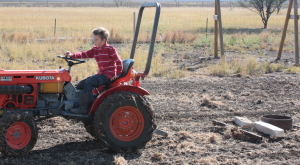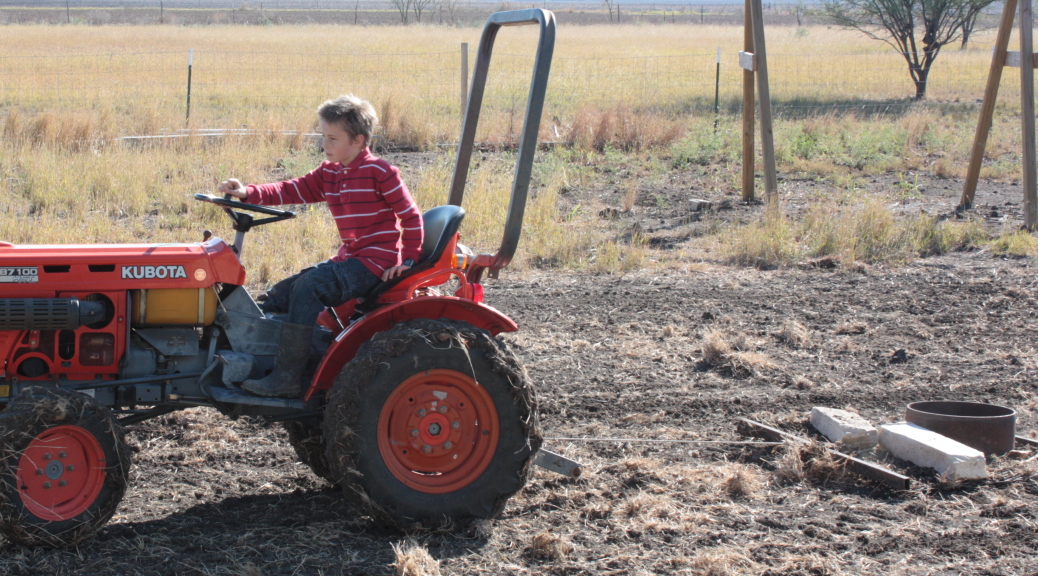Every project we’ve done so far in the “yard” has been geared towards something that produces food or is food. So far projects have included things like the barn, fence, chicken coop, electric to the barn and coop, water to the animals, etc… The only thing I’ve done to the yard is to cut back the brush and let wild grasses grow in. Not much of a yard, and not particularly good at keeping the mud down when it rains.
Now that some of the major projects are done, and all the animals have homes and water, I decided to finally break out the big bag of grass seed I bought last year and work on getting at least a small patch of grass for the kids to play on. The funny thing about the kind of clay we have here is that it’s about like an adobe brick when it’s dry, and about as sticky as rubber cement when it’s wet. This makes working it and getting it ready for seeding kinda difficult. To make matters worse, Liz is pretty adamant that I not use weed killer to get rid of the prairie grasses that “filled” the void when I cleared the brush last year.
It isn’t much fun, but a sod-buster on my puny tractor is decent at tearing up grass and the first few inches of dirt. It turns over the sod, leaving a narrow trench and extremely uneven ground that has to be run over multiple times and directions to get all of it since the wedge is much narrower than the wheelbase. My back would appreciate suspension, but that’s not a real option on my tractor. After an hour bouncing and rattling and banging through the hard dirt, the deeply furrowed and rough ground looked worse than when I started.
To try and clean things up some I used a crappy disc plow that came with the tractor to cut the big blocks of clay into smaller blocks. Along the way, the grasses got torn up for the most part. The problems with this approach are that the ground ends up pretty uneven and is completely covered in golf-ball sized chunks of hard clay, and the grass forms hard root-balls in the clay that won’t die unless you break up the roots and pull the grass out. I had to come up with something better.
A few weeks prior, I had acquired some scrap expanded metal when I taught a neighbor how to weld together a milking stand. There were two pieces of it left that would be about the width of the tractor if I welded them together on some kind of frame. I figured if I dragged the expanded metal grating across the dirt it would help to both smooth out the ground and to break up some of the chunks. A few minutes with some more scrap from the garage, some random things to weigh the sled down and my excessively cheap Harbor Freight welder, and I was in business.
It did a decent job of breaking up the chunks, and a great job of pulling the roots and grass out of the clods. After a few passes (maybe more than a few) the grass was all clumped up in a handful of balls that either blew away in the wind or were easy to pick up by hand.
The best part… I didn’t have to drag it around the yard. Isaac and Sydney are still under the delusion that driving anything that is powered by an internal combustion engine is fun. I don’t want them dragging a plow yet, but a fairly light “sled” that just smooths out the dirt seemed about right for them to cut their teeth on. I even used the kids and sled to pack or cover the seed after broadcasting it.
 The only bad part of the whole deal is that the next week it rained several inches overnight while I was out of town on business. When I called Liz later to say hi, I got an ear-full because the freshly turned and broken-up earth was now an ankle-deep muck pit that sat squarely between the house and the goat-pasture. Turns out it’s hard to walk through gloppy, sloppy, deep and sticky mud in the rain carrying a bucket of fresh milk without falling down.
The only bad part of the whole deal is that the next week it rained several inches overnight while I was out of town on business. When I called Liz later to say hi, I got an ear-full because the freshly turned and broken-up earth was now an ankle-deep muck pit that sat squarely between the house and the goat-pasture. Turns out it’s hard to walk through gloppy, sloppy, deep and sticky mud in the rain carrying a bucket of fresh milk without falling down.
It’s been a few weeks and one or two rains, and now I have a bunch of clover (on purpose) and the beginnings of a green lawn behind the house.
